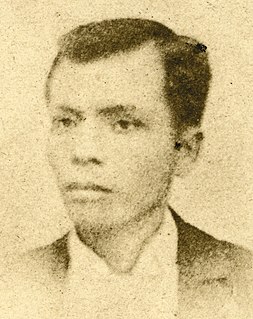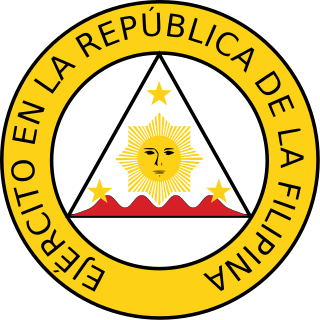List
| No. | President (Birth–Death) | Took office | Left office | Party | Vice President | Government | ||
|---|---|---|---|---|---|---|---|---|
| A |  | Andres Bonifacio y de Castro (30 November 1863 – 10 May 1897) (Lived: 33 years) [5] [10] [11] [12] | August 24, 1896 [L 1] | March 22, 1897 [L 2] or May 10, 1897 [L 3] | Katipunan | none | Sovereign Tagalog Nation aka Tagalog Republic ("Sovereign Nation of the Tagalog People"; "Republic of the Tagalog Nation/People") [L 4] | |
| B |  | Emilio Aguinaldo y Famy (22 March 1869 – 6 February 1964) (Lived: 94 years) | March 22, 1897 [L 5] | November 1, 1897 [L 6] | Katipunan (Magdalo faction) or Independent (formerly Katipunan) [L 7] | Mariano Trias y Closas | Tejeros revolutionary government ("Philippine Republic" aka "Republic of the Philippines" aka "Government of the [Whole] Tagalog Nation/People", or "Government of [All] Tagalogs" [L 8] ) | |
| November 2, 1897 [L 9] | December 14, 1897 [L 10] | Independent (formerly Katipunan) | Republic of Biak-na-Bato ("Republic of the Philippines") [L 11] | |||||
| May 24, 1898 | June 23, 1898 [L 12] | Dictatorial Government of the Philippines [L 13] | ||||||
| June 23, 1898 [L 14] | January 23, 1899 [L 15] | Revolutionary Government of the Philippines [L 16] | ||||||
| C |  | Francisco Macabulos y Soliman (17 September 1871 – 30 August 1922) (Lived: 50 years) | April 17, 1898 | May 19, 1898 [L 17] | Independent (formerly Katipunan) | none | Central Executive Committee | |
| D |  | Miguel Malvar y Carpio (27 September 1865 – 13 October 1911) (Lived: 46 years) [14] | April 1, 1901 [L 18] | April 16, 1902 [L 19] | Independent (formerly Katipunan) | none (The 1899 Constitution did not provide for a Vice President.) | First Republic aka Malolos Republic ("Philippine Republic") [L 20] | |
| E |  | Macario Sakay y de León (1870 – 13 September 1907) (Lived: 37 years) [15] [16] [17] | May 6, 1902 [L 21] | July 14, 1906 [L 22] | Katipunan (holdout/revival) | Francisco Carreón y Marcos | Tagalog Republic ("Republic of [the Archipelago of] the Tagalog Nation/People") [L 23] | |
| F |  | José Abad Santos (19 February 1886 – 2 May 1942) (Lived: 56 years) [9] | March 17, 1942 | May 2, 1942 | Independent | none | Commonwealth of the Philippines | |
| G |  | Jorge Bartolome Vargas (24 April 1890 – 22 February 1980) (Lived: 89 years) | January 23, 1942 | October 14, 1943 | KALIBAPI | none | Philippine Executive Commission | |
| H |  | Arturo Tolentino (19 September 1910 – 2 August 2004) (Lived: 93 years) [18] [19] | 6 July 1986 [H 1] | 8 July 1986 | Kilusang Bagong Lipunan | none | Fourth Republic | |
- Notes
- ↑ Term began when Bonifacio declared the establishment of the Tagalog Republic.
- ↑ Term ended after the Tejeros Convention.
- ↑ Executed for treason by Aguinaldo's government; Bonifacio did not recognize its validity and still acted as president.
- ↑ "Sovereign Nation/People" is translated from haring bayan or haringbayan, Bonifacio's Tagalog neologism adapting the term "republic", based on its Latin roots res publica ; "republic" was itself used as a synonym of haring bayan. The full original terms are Haring Bayang Katagalugan and Republika ng Katagalugan.
- ↑ Term was established at the Tejeros Convention; Aguinaldo took his oath of office the day after (March 23), but did not fully assume the office until late April 1897.
- ↑ Term ended with the establishment of the Republic of Biak-na-Bato.
- ↑ Aguinaldo was elected President of a new government by fellow members of the Katipunan, but the new government considered the Katipunan per se to be dissolved/superseded when it came into existence to replace it.
- ↑ The Tejeros government called itself Republica Filipina, Republica de Filipinas and Pamahalaan ng Sangkatagalugan (akin to Bonifacio's preferred terminology) and so it does not yet have a standardized name in Philippine historiography.
- ↑ Term began after the establishment of the Republic of Biak-na-Bato.
- ↑ Term ended when Aguinaldo signed the Pact of Biak-na-Bato.
- ↑ "Republic of Biak-na-Bato" is a term used by Filipino historians to distinguish it from other Philippine Republics; it called itself Republica de Filipinas.
- ↑ Term ended when Aguinaldo shifted from dictatorial to revolutionary government.
- ↑ Aguinaldo formally held the title of "Dictator", was not formally "President" again until the end of the Dictatorial Government and the start of the pre-Malolos Revolutionary Government.
- ↑ Term began with the declaration of a revolutionary government replacing the dictatorship. [13]
- ↑ Term ended with the inauguration of the Malolos Republic, considered the First Philippine Republic.
- ↑ Replaced the Dictatorial Government, but both did not call themselves a "Republic". Replaced by the First Republic.
- ↑ Term ended upon the return of Aguinaldo, who established a dictatorship.
- ↑ Term began when Malvar presumptively assumed the presidency after the capture of Aguinaldo.
- ↑ Term ended when Malvar surrendered in Batangas.
- ↑ "Malolos Republic" is a term used by Filipino historians to distinguish it from other Philippine Republics; it called itself Republica Filipina.
- ↑ Term began when Sakay declared the establishment of the Tagalog Republic (in the tradition of Bonifacio instead of Aguinaldo).
- ↑ Term ended when Sakay surrendered as part of an amnesty; he was executed a year later.
- ↑ The original term is Republika ng [Kapuluang] Katagalugan.














